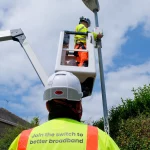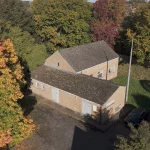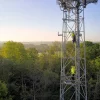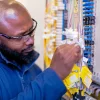Dr John Cioffi on the Viability of 1 Terabit DSL Copper Line Broadband
Broadband ISP speeds of 1 Terabit per second (1000000Mbps) down a traditional copper line? It may sound impossible but that’s what Dr John Cioffi, best known as the “father” of DSL, proposed last year (here) with Terabit DSL technology. In our latest interview we ask John about TDSL’s viability.
At present the vast majority of consumers in the UK connect their broadband ISP services via a form of Digital Subscriber Line technology (e.g. ADSL, VDSL [FTTC] etc.), which sends electrical signals down a tiny bit of twisted pair copper wire in order to deliver an internet connection into your home.
Two of the key people involved with the development of DSL were Joseph Lechleider and Stanford Professor Dr John Cioffi. The latter is a seasoned electrical engineer that has published over 600 papers and holds over 100 patents (many related to ADSL, VDSL, Vectored VDSL, G.fast, DSM, LTE, Massive-MIMO and Wi-Fi). On top of that he’s also the CEO and Chairman of California-based ASSIA.
Advertisement
Suffice to say that if it were anybody else proposing Terabit DSL then we might struggle to take it seriously but that’s definitely not the case with John.
What is TDSL?
At present modern Fibre-to-the-Cabinet (FTTC) style broadband technologies like G.fast can harness 106MHz of spectrum (rising up to 212MHz in the future) and tend to deliver their best speeds at under a few hundred metres from your local street cabinet, with electrical signals travelling inside the copper wire.
Future enhancements like XG.Fast / G.mgfast may even be able to use up to around 848MHz of spectrum but these will suffer even more from signal degradation over distance, meaning you’ll need a very short line in order to get the best performance and some doubt that today’s increasingly “full fibre” (FTTP/H) focused operators will ever adopt it.
By comparison TDSL proposes the radically different approach of using the existing copper wire as a “guide” (waveguide) to help direct a wireless broadband signal in the 100GHz+ millimeter Wave (mmW) band, which could carry huge amounts of data.
Advertisement
One early model predicts that speeds of 100Gbps (Gigabits per second) could be achieved at distances over 300 metres (future G.fast upgrades might deliver c.500Mbps at this distance), while 10Gbps might work at distances over 500 metres and even those on longer lines of 700 metres could potentially achieve symmetric speeds of around 1Gbps.

The fact that such speeds could be achieved, without needing to replace existing copper cables with expensive “full fibre” infrastructure, is a significant incentive for operators to explore the approach. Unfortunately at present TDSL is just a model and ASSIA are keen to drum up support for further research and funding.
On top of that there’s a question mark over the real-world viability of using mmW spectrum in such a way, which is a band that can be easily disrupted (such signals usually don’t travel very far without a dense or powerful network to keep them stable). On the other hand, back in the days of 14Kbps dial-up modems, few could have envisaged that a 1Gbps capable copper technology like G.fast might ever exist.
Advertisement
Dr. John Cioffi is due to talk more about all this on 20th June (15:40) at the TNO Ultra-fast Broadband Seminar in The Netherlands, but before then he’s kindly granted us an interview to discuss TDSL and the challenges involved with its potential adoption.
The Interview
1. Generally when somebody mentions DSL (Digital Subscriber Line) I tend to think of electrical signals travelling inside a metallic copper or aluminium cable. In keeping with that the title of your new ‘Terabit DSL’ (TDSL) solution has perhaps caused some confusion because it actually works in quite a fundamentally different way. Would you mind explaining the core differences to our readers?
ANSWER:
You are correct about DSL to date having used the transmission-line mode of operation of a metallic cable. This is only one of the modes of transmission (there are others that arise in solving the famed Maxwell Equations that largely govern the electromagnetic wave propagation that is fundamental to all wireless and wireline communication). The other “higher-order” modes are often called the “waveguide modes.” Your readers can think of the waveguide modes as “wireless transmission” around the wires, guided by those wires rather than flowing in the wires. The wires’ presence helps the wireless work better in most cases – that is the waveguide.
Exploiting the waveguide modes of a binder of twisted pair connections involves a coordinated set of transmitters and receiver, not just one of each. This set of transmitters and receivers is the equivalent of the multiple antennas used in MIMO [Multiple-Input and Multiple-Output]. The coordinated processing allows clean up of the messy spatial interference (called crosstalk) between all the waves propagated around and between the wires. Normal waveguides (like fiber) usually don’t need MIMO and have a single transmitter and receiver (usually – MIMO is starting to be used in fiber also). The twisted pairs need it badly to have a chance at working. If it all can be coordinated well, there is a chance for Terabits/Hz of information to be transmitted over 100 meters. Lower speeds can go further (it looks like 10 Gbps at 500m).
The antennas are very tiny and closely packed in this case because the frequencies used are very highly (100 GHz to 1 Teraherz) where a wavelength is 3 mm down to .3 mm so an entire set of them can be packed closely (and even manufactured as a single module using 3D printing/manufacturing technology).
I hope this helps and was not too technical for your readers.
2. When we first heard about TDSL it sounded like little more than a mathematical model. How far along is this technology in its development and when do you think we might see the first real trials taking place?
ANSWER:
There are some initiatives and many ideas on how to test the waveguide propagation in various situations. There is some US Government interest in funding it at the right labs – I am trying to encourage that funding to the right places to characterize and investigate further.
3. With so many operators now investing in FTTP/H, isn’t TDSL at risk of arriving too late to the party and where do you envisage it being used?
ANSWER:
That’s been said for decades now with twisted pair (too late to the party). Indeed in the mid 1990’s before any even slower DSLs were deployed, venture capital groups would not fund those efforts for the same reason (had to be fiber). The reality is that the replacement of the 1.3B global telephone lines by fiber is a very expensive and time-consuming process. Realistic estimates of cost, based well on the costs today, are that it is AT LEAST an average of $3000/line, so that is $4 Trillion to do it. Its also a very long time as well.
Thus, I’ve tried not to let that “fiber will be everywhere in 3 years” that I have heard regularly since 1989 get too much in the way of the advance of methods that can help. The copper is there and will be for a long time, so we might as well do our best to use it and not get too concerned in its replacement.
Today, many “fiber” connections still have a DSL at the end of them – its just called fiber. If you count these, the global number is roughly 500M DSL connections. Replacing the last drop segment to the consumer residence is the most expensive part of fiber replacement, so it is often not done even when the fiber gets closer, shortens the copper, and thus higher speeds are possible.
Continued on page 2..
Mark is a professional technology writer, IT consultant and computer engineer from Dorset (England), he also founded ISPreview in 1999 and enjoys analysing the latest telecoms and broadband developments. Find me on X (Twitter), Mastodon, Facebook, BlueSky, Threads.net and Linkedin.
« Virgin Media TV Customers Who Take Netflix to Get Single Billing

















































Comments are closed